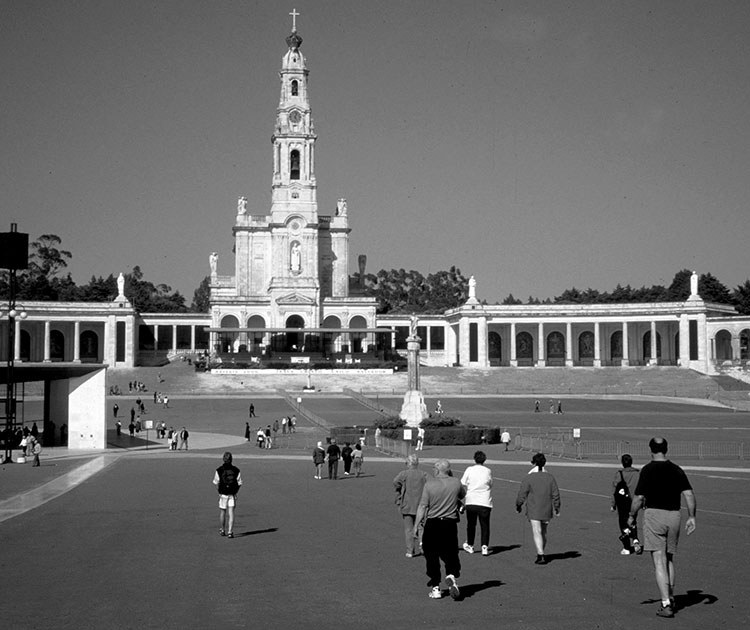Portugal — one foot in the past, one in the future
This item appears on page 70 of the September 2008 issue.

With its membership in the European Union, many things are changing in Portugal.
Day after day, the roads there were messing up my itinerary. I’d arrive in town hours before I thought I would. I remember a time when there were absolutely no freeways in Portugal. Now the country has plenty. They build them so fast, even my Michelin map was missing new ones.
There were other signs that Portugal is well into its EU upgrade. In the past, open fish stalls lined the streets; now they’ve been moved into “more hygienic” covered shops. Widows no longer wear black. Rather than crusty old locals doing the hard work, you see lots of immigrant laborers.
Yet, in spite of the EU, Portugal is still a humble and relatively isolated place. Driving into Nazaré, you’ll still see women squatting on the curb as you enter the town. Their hope — to waylay tourists from reserved hotel rooms with signs saying “Quartos!,” meaning rooms for rent. . . cheap. (By the way, simple hotels all over Portugal rent decent double rooms for $60. And, even with the weak U.S. dollar, passable dives can be had for $40 per double.)
Service is friendly in the hole-in-the-wall restaurants, where menus come with two columns: half “dose” and full “dose” (€4 and €6, respectively), full “dose” designed to be split by two, which means traveling couples can dine for less than $5 each.
I’ve noticed all over Europe that monks are famous for brewing beer and distilling liquors. But in Portugal, menus are rounded out by a fun selection of nun-inspired pastries called “convent sweets.”
Portugal once had access to more sugar than any other European country. Even so, sugar was so expensive that only the aristocracy could afford to enjoy it routinely. Historically, daughters of aristocrats who were unable to marry into noble families ended up in high-class convents. Life there was comfortable yet carefully controlled. Rather than romance, they could covet and treat themselves with sweets.
Over time, the convents became famous as keepers of secret recipes for exquisite pastries generally made from sugar and egg yolks (which were leftovers from egg whites used to starch their habits). Barrigas de Freiras (Nuns’ Tummies) and Papos de Ango (Angel’s Breasts) are two such fancies.
For a good sampling, I’ve taken to asking for “mixta dulce,” and waiters are happy to bring a nibble of several of their top sobremesas (desserts).
While they are enthusiastic about sweets from convents, young people don’t go to church much in Portugal these days, but the country is remarkably Catholic for the sightseer. The main sights of most towns are the musty old churches, those Gothic, stone shells crammed with dusty, gold-leaf Baroque altars. Even my stop for the night, Nazaré, was named for Nazareth.
Nearby, Fátima is one of Europe’s top pilgrimage destinations. In 1917, three kids encountered the Virgin Mary near the village of Fátima and were asked to return on the 13th of each month for six months. The final apparition was witnessed by thousands of locals. Ever since, Fátima is on the pilgrimage trail, mobbed on the 13th of each month through the spring and summer.
On my visit, the vast esplanade leading to the basilica and site of the mystical appearance was quiet. A few solitary pilgrims shuffled on knees slowly down the long, smooth approach. Inside the church, I found a forest of candles dripping their wax into a fiery trench that funnels the hot liquid into a bin to be “resurrected” as new candles.
Huge letters spelling “Queen of the Holy Rosary of Fátima Pray for Us” in Latin ring the ceiling of the basilica. Pope John Paul II loved Fátima and visited it three times. (After the attempted assassination of John Paul, the Vatican revealed that the incident was predicted by Our Lady of Fátima in 1917.)
Wandering around modern Fátima and its commercial zone, I was impressed by how it mirrored my image of a medieval pilgrim zone: oodles of picnic benches, endless parking, and desolate toilets for the masses.
Just beyond the church, 30 stalls lining a mall awaited the monthly onslaught on the 13th. Even without any business, old ladies still watched over their booths, surrounded by trinkets for pilgrims, including gaudy wax body parts and rosaries that would be blessed after Mass and taken home to remember Our Lady of Fátima.
Vivid memories of Portugal — whether heavenly sweets or slick new freeways — are abundant in this country with one foot in the past and one in the future.
